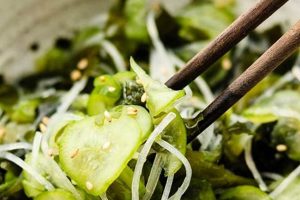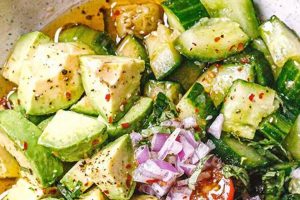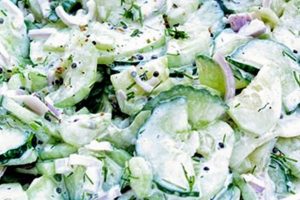Refreshing and crisp, combinations of thinly sliced cucumbers and onions form the base of a versatile salad. These salads can range from simple preparations with a light vinaigrette to more complex versions incorporating herbs, spices, other vegetables, or even fruits. A classic example includes thinly sliced red onion and cucumber dressed with a mixture of vinegar, oil, salt, and pepper.
Such salads offer a healthy and flavorful addition to any meal. Cucumbers provide hydration and important vitamins, while onions contribute a pungent bite and offer various health benefits. Historically, these ingredients have been paired together in cuisines worldwide, demonstrating their enduring appeal and adaptability. The simplicity of these salads also makes them a practical and economical choice.
This article will explore various preparations, from basic vinaigrette dressings to more elaborate recipes. It will also cover tips for ingredient selection, preparation techniques, and creative variations to enhance flavor profiles and presentation.
Tips for Onion and Cucumber Salads
Optimizing ingredient preparation and combining flavors are crucial for creating a successful salad. The following tips offer guidance for achieving the best results.
Tip 1: Salt the cucumbers: Salting sliced cucumbers draws out excess moisture, preventing a watery salad. Place the cucumber slices in a colander sprinkled with salt for about 15 minutes before rinsing and drying.
Tip 2: Soak the onions: Soaking thinly sliced red onions in cold water for 10-15 minutes mellows their sharpness, resulting in a milder flavor.
Tip 3: Balance flavors: Achieve a balanced flavor profile by incorporating acidity, sweetness, and saltiness. Vinegar or lemon juice provides acidity, a touch of sugar offers sweetness, and salt enhances the overall taste.
Tip 4: Choose fresh herbs: Fresh herbs like dill, mint, or parsley elevate the salad’s flavor and aroma. Add them just before serving to retain their vibrancy.
Tip 5: Experiment with textures: Incorporating ingredients like toasted nuts, seeds, or crumbled feta cheese adds textural complexity and visual appeal.
Tip 6: Chill before serving: Chilling the salad for at least 30 minutes allows the flavors to meld and enhances the refreshing quality.
Tip 7: Consider the dressing: A simple vinaigrette is classic, but consider exploring other options like yogurt-based dressings or those with a touch of honey or mustard.
By following these tips, one can elevate a simple cucumber and onion salad to a flavorful and refreshing dish. Attention to detail, from ingredient preparation to flavor balancing, ensures a delightful culinary experience.
These insights provide a strong foundation for creating delicious cucumber and onion salads. The following section offers specific recipe variations for further exploration.
1. Ingredient Quality
Ingredient quality significantly impacts the final flavor and texture of onion and cucumber salads. Subpar ingredients can result in a bland or unpleasant experience, while high-quality components elevate the dish to a refreshing and flavorful level. Understanding the nuances of ingredient selection is crucial for creating a successful salad.
- Cucumber Selection
Cucumbers should be firm and vibrant in color, free from blemishes or soft spots. Different varieties offer varying flavor profiles; English cucumbers are known for their mild sweetness and thin skin, while Persian cucumbers offer a slightly sweeter and more delicate flavor. Selecting the right cucumber variety contributes significantly to the overall taste and texture of the salad.
- Onion Variety
The choice of onion significantly influences the salad’s flavor profile. Red onions provide a sharp, pungent taste, while sweet onions like Vidalia or Maui offer a milder, sweeter flavor. Shallots present a delicate balance between sweet and savory. Consider the desired flavor intensity when selecting the onion variety. For example, a bolder flavor profile may benefit from red onions, while a milder salad might utilize sweeter onion varieties.
- Freshness of Herbs
Fresh herbs play a vital role in enhancing the salad’s aroma and flavor. Wilted or dried herbs lack the vibrant taste and visual appeal of fresh herbs. Dill, mint, parsley, and chives are popular choices, each contributing a unique flavor dimension. Using fresh, high-quality herbs elevates the sensory experience of the salad.
- Sourcing Produce
Locally sourced, seasonal produce often offers superior flavor and nutritional value compared to produce shipped long distances. Farmers’ markets or local farms can provide access to fresh, high-quality ingredients. Considering the source of the produce ensures optimal flavor and supports local agriculture.
By prioritizing high-quality ingredients, one ensures a flavorful and enjoyable culinary experience. The careful selection of cucumbers, onions, and herbs elevates a simple onion and cucumber salad from ordinary to extraordinary. This attention to detail transforms the salad into a delightful and refreshing dish.
2. Precise Slicing
Precise slicing techniques are fundamental to a successful onion and cucumber salad. Uniformity in cuts ensures even marinating, consistent texture, and an aesthetically pleasing presentation. This attention to detail elevates the salad from a simple side dish to a carefully crafted culinary creation.
- Uniformity of Pieces
Consistent slicing ensures that each piece of cucumber and onion absorbs the dressing evenly, resulting in a balanced flavor throughout the salad. Unevenly sized pieces can lead to some parts being over-marinated while others remain under-dressed. This uniformity also contributes to a more pleasant eating experience.
- Thickness and Texture
The thickness of the slices directly impacts the salad’s texture. Thinly sliced cucumbers and onions offer a delicate crispness, while thicker slices provide a more substantial bite. The desired texture dictates the appropriate slicing technique. Thin slices are ideal for delicate salads, whereas thicker slices may be preferred for heartier preparations.
- Aesthetic Presentation
Precise slicing contributes to the visual appeal of the salad. Uniformly cut vegetables create a visually harmonious and attractive presentation. This attention to detail elevates the dining experience, transforming a simple salad into a visually appealing dish.
- Slicing Methods
Different slicing methods yield different results. Mandolines create perfectly uniform slices, while sharp knives allow for greater control and versatility. The chosen method influences the final presentation and texture of the salad. A mandoline is ideal for achieving very thin, even slices, while a knife offers greater flexibility for varied cuts.
The precision employed in slicing cucumbers and onions directly correlates with the overall quality and enjoyment of the salad. From flavor distribution to textural consistency and visual appeal, precise slicing techniques are essential for creating a truly exceptional dish. Mastery of these techniques distinguishes a simple preparation from a carefully crafted culinary experience.
3. Flavor Balancing
Flavor balancing is paramount in crafting exceptional onion and cucumber salads. A harmonious blend of contrasting yet complementary tastes elevates this simple dish. Careful consideration of acidity, sweetness, saltiness, and savory notes ensures a complex and satisfying flavor profile. This section explores the key facets of flavor balancing within the context of these refreshing salads.
- Acidity
Acidity provides brightness and cuts through the richness of the other ingredients. Vinegars, such as white wine, apple cider, or rice vinegar, contribute distinct acidic notes. Lemon or lime juice offer a citrusy alternative. The level of acidity should be carefully calibrated to complement, not overpower, the other flavors. For example, a salad with delicate cucumbers and sweet onions benefits from a milder vinegar like apple cider, while a salad incorporating bolder ingredients may require the sharper tang of red wine vinegar.
- Sweetness
A touch of sweetness balances the acidity and adds depth to the flavor profile. Sugar, honey, or maple syrup can be incorporated into the dressing. Sweet onion varieties, such as Vidalia or Maui, also contribute inherent sweetness. The sweetness should be subtle, enhancing rather than dominating the overall taste. A small amount of sugar in a lemon vinaigrette, for example, balances the tartness and rounds out the flavor profile.
- Saltiness
Salt enhances the flavors of the other ingredients and provides a foundational savory element. The amount of salt should be carefully measured to avoid overpowering the delicate flavors of the cucumbers and onions. Sea salt or kosher salt are preferred choices, offering a cleaner flavor than table salt. Salting the cucumbers before adding them to the salad also draws out excess moisture and concentrates their flavor.
- Savory Notes
Savory notes add complexity and depth to the salad. Fresh herbs like dill, mint, or parsley introduce herbaceous undertones. Alliums, such as chives or scallions, provide a pungent bite. Spices like black pepper or red pepper flakes offer warmth and subtle heat. Incorporating ingredients like crumbled feta cheese, toasted nuts, or sesame seeds introduces savory nuances and textural contrast. A sprinkle of toasted sesame seeds, for instance, adds a nutty, savory dimension to a cucumber and onion salad with a rice vinegar dressing.
Achieving a harmonious balance among these flavor components is crucial for creating a truly exceptional onion and cucumber salad. The interplay of acidity, sweetness, saltiness, and savory notes transforms a simple combination of ingredients into a complex and refreshing dish. This careful orchestration of flavors elevates the salad from a basic side to a culinary highlight.
4. Dressing Choice
Dressing choice significantly influences the overall flavor profile and character of onion and cucumber salads. The dressing acts as a unifying element, binding the individual ingredients and imparting a cohesive taste. A thoughtfully selected dressing elevates the simple combination of cucumbers and onions, transforming it into a complex and flavorful dish. The interplay between the dressing and the inherent flavors of the vegetables is crucial. For instance, a light vinaigrette complements the delicate flavors of the cucumbers and onions without overpowering them, while a creamy dressing adds richness and textural contrast.
The acidity, sweetness, and savory notes within the dressing must harmonize with the vegetables’ natural characteristics. A highly acidic dressing might overwhelm the subtle sweetness of cucumbers, while an overly sweet dressing could clash with the sharpness of red onions. A classic vinaigrette, composed of vinegar, oil, and seasonings, offers a versatile base. Variations incorporating herbs, spices, or other flavoring agents allow for customization and creativity. A lemon-dill vinaigrette, for example, enhances the refreshing qualities of the salad, while a creamy yogurt-based dressing with garlic and herbs adds a tangy and savory dimension. The choice of dressing should reflect the desired flavor profile and complement the specific ingredients used.
Understanding the impact of dressing choice is essential for creating balanced and flavorful onion and cucumber salads. The dressing should enhance, not mask, the inherent flavors of the vegetables. Consideration of acidity, sweetness, and savory notes within the dressing ensures a harmonious and satisfying culinary experience. The dressing effectively becomes the defining element, transforming a simple combination of ingredients into a well-composed and refreshing dish.
5. Creative Additions
Creative additions transform basic onion and cucumber salads into dynamic, multi-dimensional culinary experiences. These additions introduce textural complexity, enhance visual appeal, and expand the flavor profile beyond the foundational ingredients. Strategic incorporation of complementary elements elevates the salad from a simple side dish to a more substantial and satisfying component of a meal.
- Textural Contrasts
Incorporating elements with contrasting textures provides a more engaging sensory experience. Toasted nuts, such as slivered almonds or chopped walnuts, offer a satisfying crunch. Seeds, like sesame or sunflower seeds, contribute a delicate crispness. Crumbled feta cheese introduces a creamy counterpoint to the crisp vegetables. Even the addition of croutons can provide a welcome textural variation.
- Flavor Enhancements
Expanding the flavor profile beyond the core ingredients adds depth and complexity. Fresh herbs, like dill, mint, or parsley, introduce bright, herbaceous notes. Spices, such as freshly cracked black pepper or a pinch of red pepper flakes, contribute warmth and subtle heat. Incorporating ingredients like chopped olives, capers, or sun-dried tomatoes introduces briny and savory nuances. A sprinkle of sumac adds a tangy, citrusy element.
- Visual Appeal
Visual appeal enhances the overall dining experience. Colorful additions, like chopped bell peppers or halved cherry tomatoes, create a vibrant presentation. Edible flowers, such as nasturtiums or pansies, add an elegant touch. A sprinkle of chopped fresh herbs provides a pop of color against the backdrop of the cucumbers and onions. Attention to visual details elevates the perceived value of the dish.
- Fruit Integration
Integrating fruits introduces an element of sweetness and contrasting textures. Sliced grapes or berries, such as strawberries or blueberries, complement the refreshing nature of the salad. Diced apples or pears add a crisp, sweet element. The choice of fruit should complement the chosen dressing and other flavor components. A salad with a honey-lime dressing, for instance, might benefit from the addition of segments of orange or grapefruit.
Thoughtful incorporation of creative additions elevates onion and cucumber salads from simple to sophisticated. These additions enhance the sensory experience, offering textural contrasts, expanded flavor profiles, and increased visual appeal. By carefully considering these elements, one can transform a basic salad into a more complex and satisfying culinary creation. The possibilities are vast, limited only by culinary imagination and a willingness to experiment with flavors and textures.
Frequently Asked Questions
This section addresses common inquiries regarding onion and cucumber salads, offering practical solutions and clarifying potential misconceptions.
Question 1: How can one prevent a watery cucumber salad?
Salting sliced cucumbers draws out excess moisture. Place cucumber slices in a colander, sprinkle with salt, and let sit for 15-20 minutes. Rinse and pat dry before incorporating into the salad.
Question 2: How can the sharpness of raw onions be mellowed?
Soaking thinly sliced onions in ice water for 10-15 minutes reduces their pungency, resulting in a milder flavor.
Question 3: What are the best storage practices for onion and cucumber salads?
These salads are best consumed fresh. If storage is necessary, refrigerate in an airtight container for no more than 24 hours. The texture may soften slightly over time.
Question 4: Can other vegetables be added to onion and cucumber salads?
Certainly. Tomatoes, bell peppers, radishes, and avocado complement cucumber and onion well. Consider flavor and texture compatibility when incorporating additional vegetables.
Question 5: What dressings best complement onion and cucumber salads?
Light vinaigrettes based on vinegar or citrus juice enhance the refreshing nature of these salads. Yogurt-based dressings or those with a touch of honey or mustard also offer complementary flavor profiles.
Question 6: How can one prevent herbs from wilting in the salad?
Add fresh herbs just before serving to maintain their vibrancy and prevent them from becoming soggy.
Addressing these common inquiries provides a comprehensive understanding of optimal techniques for preparing and enjoying onion and cucumber salads. Careful preparation and thoughtful ingredient selection ensure a consistently satisfying culinary experience.
This FAQ section offers practical guidance for achieving optimal results when preparing this refreshing and versatile dish. Further exploration of specific recipe variations follows.
Onion and Cucumber Salad Recipes
Exploration of onion and cucumber salad recipes reveals a dish adaptable to various culinary preferences. From simple vinegar-based dressings to more complex additions of herbs, spices, and other vegetables, the foundational combination of cucumbers and onions offers a versatile canvas for culinary creativity. Precise slicing techniques, careful ingredient selection, and balanced flavor profiles are key determinants of a successful outcome. Addressing common preparation challenges, such as excess cucumber moisture and pungent raw onions, further enhances the culinary experience. Understanding the interplay of acidity, sweetness, and savory elements within the dressing is crucial for achieving a harmonious and flavorful final product.
The enduring appeal of onion and cucumber salads lies in their refreshing simplicity and adaptability. Continued exploration of flavor combinations and creative additions promises further evolution of this culinary staple. Potential future innovations may incorporate regional variations, novel ingredient pairings, and adaptations to diverse dietary preferences. The inherent versatility of this simple yet elegant dish ensures its continued presence in culinary traditions worldwide.






